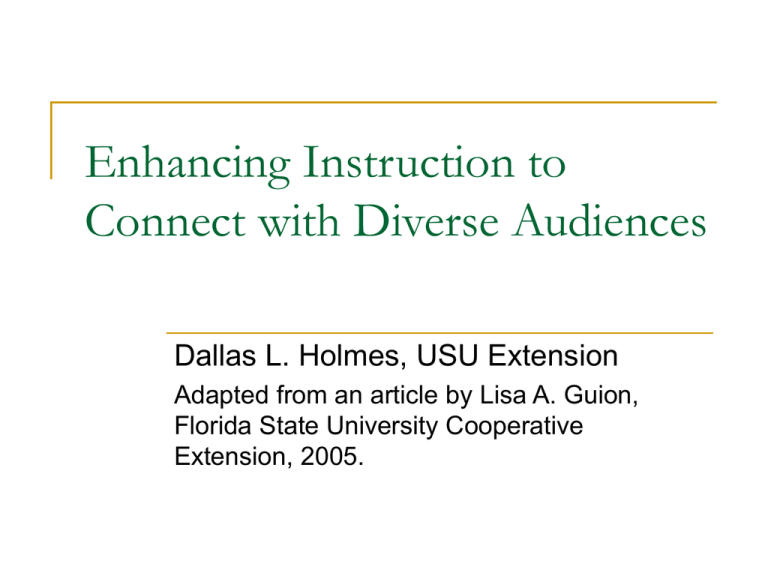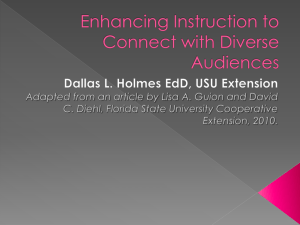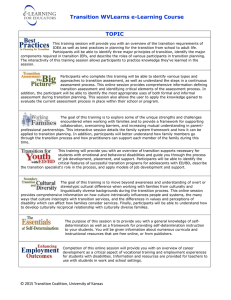Enhancing Instruction to Connect with Diverse Audiences Dallas L. Holmes, USU Extension
advertisement

Enhancing Instruction to Connect with Diverse Audiences Dallas L. Holmes, USU Extension Adapted from an article by Lisa A. Guion, Florida State University Cooperative Extension, 2005. Education and Social Constructs Social science literature has revealed that a person’s way of thinking, behaving, and being are deeply influenced by race/ethnicity, social class, language, and other cultural constructs. Likewise, the preferred way in which information is delivered is also closely tied to social constructs. An individual’s learning style, in most cases, is culturally influenced. Ethnic Learning Styles The degree that the individual’s learning style is influenced by culture depends on the person’s level of ethnicity, which is contingent upon many environmental, economic, and social factors. Thus, educators must identify the learning style preference of the diverse clientele they wish to reach. Educator Preparation Educators tend to teach the way that they prefer to learn. Visual learners are visual teachers. It is important to recognize this tendency in order to structure teaching strategies for diverse groups effectively. Educator Preparation Once the educator has identified his or her own style of learning, it is important to find out how the diverse individuals prefer to learn. Consult the literature on preferred cultural learning styles. Validate your findings via cultural brokers (guides), surveying (telephone, written, email), or a representative sample of the targeted clientele to determine if the cultural learning style holds true for the majority. Benefits of Culturally Appropriate Instruction Increases participation in a program Increases interest in a topic Enhances learning of the subjects taught Shows respect for their culture Shows commitment to planning programs for a diverse audience. Key Components for Culturally Appropriate Instruction Developing a clear sense of your own cultural identity. Learning about the cultural backgrounds and experiences of diverse individuals you work with or desire to work with. Learning how to be a competent and effective cross-cultural communicator. Becoming cognizant of the divergent styles of thinking and learning of diverse populations. Recognizing the needs, preferences, strengths, and experiences of individuals from diverse cultures. Incorporating culturally relevant curriculum materials and instructional aids. Key Components for Culturally Appropriate Instruction Using multiple modes of teaching to accommodate different learning styles. Having positive expectations of all students. Encouraging community involvement as well as parental involvement. Learning about your Clientele, Their Families, and Communities Engage families in programming from conception to implementation. Get involved in activities and events that are important in the community. Get assistance and support from opinion leaders, gatekeepers and informal leaders. Assemble a focus group of individuals from the target audience to gain insight into their learning styles. Pilot test a lesson using various learning approaches, then assess which approach is most effective. Culturally Relevant Educational Materials Equal in importance to using a culturally appropriate teaching method, is using culturally appropriate teaching materials. Even if it seems that your curriculum need not be changed, no matter what the audience, research has shown that due to different cultural norms, values, beliefs, practices and traditions within a given ethnic group, the way the principles are presented may need to vary in order to reach the audience. Culturally Relevant Educational Materials Before choosing any curriculum or educational resource for a specific group, an educator should ask the following questions: Is the content accurate and research-based? Is the material written at the appropriate readinglevel? Are the applications and activities appropriate for the needs of the audience? Does the curriculum cover issues/topics on the subjects that are important to the audience? Culturally Relevant Educational Materials Does it provide interesting application exercises for applying the ideas? Are the examples relevant to the life experiences of the audience? (Do visual aids reflect the audience’s ethnicity?) Does the content reflect the norms, values, and preferences of the target audience and avoid negative stereotyping? When related to the subject content, are the cultural observances acknowledged and/or celebrated? Does the curriculum involve users as partners in applying the principles taught in the lessons to their lives? Enhancing Instruction to Connect with Diverse Audiences Certain teaching styles and learning aids that are appropriate for one group may not be appropriate for a group from a different cultural background. It may be difficult given time constraints, responsibility for multiple programs, understaffing, etc., however small steps can and should be taken to build classrooms where all participants have the optimum chance of learning. Farm Safety Classes for Latino Farm Workers Craig Poulson and A.J. Fergusen of the Farm Bureau conducted classes on farm safety with Latino agricultural workers in San Pete County in 2004. Farm Safety Classes for Latino Farm Workers Get assistance and support from opinion leaders, gatekeepers and informal leaders. “We taught the class entirely in Spanish. . . We also had help from Dr. David Frame (USU Extension Turkey research), Pedro Ramirez (Local Farm Worker), Dr. Jose Munoz (Hispanic Medical Doctor from Richfield). . . Contact local minority leaders, i.e. Hispanic Church leaders or others in the community who work with the Hispanic community, to help gain support.” Farm Safety Classes for Latino Farm Workers Incorporate culturally relevant curriculum materials and instructional aids. “We gave each participant a folder with safety information in Spanish and snacks. We provided chips and salsa along with some cookies and drinks.” Make the applications and activities appropriate for the needs of the audience “When asked if they felt the class was something important for them to take every participant answered ‘Yes.’” References Allison, B.N. (2003). Multicultural classrooms: Implications for family and consumer sciences teachers. Journal of Family and Consumer Sciences, 95(2), 38-43. Banks, J.A., Cookson, P., Gay, G., & Whawley, W.D. (2001). Diversity within unity: Essential principles for teaching and learning in a multicultural society. Phi Delta Kappan, 83(3), 196210. Guion, L. A., Goddard, H.W., Broadwater, G., Chattaraj, S., & Sullivan-Lytle, S. (2003). Strengthening programs to reach diverse audiences. Gainesville, FL: Florida Cooperative Extension, University of Florida. McCarthy, C. (1994). Multicultural discourses and curriculum reform: A critical perspective. Educational Theory, 44(1).



